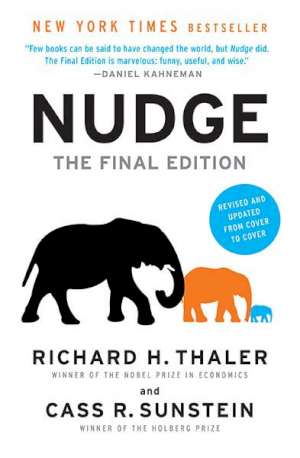29 November 2021
Nudge: The Final Edition
Richard H. Thaler and Cass R. Sunstein
2021, Yale University Press, 384 pages,
ISBN 9780300262285
Reviewer: Vicky Pryce, Chief Economic Adviser & Board Member, CEBR

His work in behavioural economics, applying findings of psychology into microeconomic decision-making, won the Nobel Prize in Economics for Richard Thaler in 2017. And his 2008 “Nudge” book, co-written with Cass Sunstein ensured that behavioural economics came centre-stage in policy-making. It suggested that human beings can be encouraged to do the ‘right’ thing for themselves and society through a series of choice incentives and better information, if those incentives were correctly offered.
This book, an update of the earlier volume, has ‘The Final Edition’ as a subtitle. The authors make a clear pledge to the reader to absolutely not expect a ‘post-Final’ update. But they are clearly not sure themselves: As they finish their introduction , having gone to great lengths to explain the reason for their decision that this is indeed the final edition comes this sentence: ‘And one of us actually believes that pledge’ Ah! The mystery of psychology!
Thaler and Sunstein fully accept that not everyone likes nudge and that many view it with suspicion. And the outcomes can go badly wrong if ‘nudge’ is badly applied. They also acknowledge that there have been worries that some ‘bad’ people will read their book and then use what is in it to achieve their ends and that the book could fall ‘into the hands of bullies and crooks’. But as they say the existence of villains predates their book so it shouldn’t be at the top of people’s concerns!
There are also those who believe that nudging compromises freedom of choice. And there are concerns that the activity of public sector ‘Nudge Units ’ that have sprung up in many countries and regions across the world may get in the way of bigger issues that need to be addressed more sustainably- through regulation, mandates and bans of various kinds.
But the authors believe that those Nudge Units have in fact accomplished a lot. And although there could indeed be a degree of ‘nudgephobia’, they point to so many other phobias that are plain silly and, by implication, nudgephobia can also be described as such. They mention a few: sciophobia- the fear of shadows (from the Greek word skia, meaning shadow of course, and phobia meaning fear.) And arachibuturophobia, which as they explain is ‘fear of peanut butter sticking to the roof of your mouth(Greek etymology mostly again, though not sure if peanut butter was in widespread use in ancient Greece..)
However eccentric and amusing this may all seem (and there are plenty more Greek-based examples I could have given) there is a serious point behind it. We tend to worry about the original issue, say shadows, because we think that if A then B and C may follow which we don’t like. But assuming that, indeed, we will end up with C and so let’s not have A just in case is the wrong approach. Nudge and the use of behavioural economics can lead to good outcomes, at little cost – though the authors admit that the need to get the communication right and encourage behavioural change to take place (nudging savers to provide for pensions, for example) may indeed result in enriching advertisers hired to spread the word in the short to medium term above all others! But this is a small price to pay surely for better outcomes if that is indeed what we get.
This eminently readable and most enjoyable book has a few new chapters added to it since 2008. The authors have taken out areas that are now seen as obsolete due to technological advances since the book was first written. New chapters cover areas such as ‘Sludge’, a term they use to indicate the bureaucratic difficulties in attempting to take action – which still acts as a disincentive to change in so many areas and so many countries around the world. There is also a chapter devoted to ‘Smart Disclosure’ of important information by government to help people choose on the basis of better knowledge. In both cases we can see a market failure existing that needs to be tackled. All good ideas as long as that information is right and unbiased, one guesses.
Finally the authors admit that one of the hardest nuts to crack with the use of Nudge is changing behaviour to save the planet. The right price signals here will be crucially important but so too will be legally required disclosure of greenhouse gas emissions of sectors, companies and activities.
For the consumer, inertia is a powerful force here as in many other aspects of life but the issue as we know is huge. Thaler and Sunstein argue that getting the desired results requires making the green default option easy. As a test case they quote an experiment in Germany which looked at the number of customers choosing a green energy option if offered the choice against those who were automatically enrolled into a green energy supplier and were given the option to opt out. The percentage of contracts purchased from green suppliers in option one in that randomized controlled trial was 7.2%. Under option 2, the opt-out option, the share moved to 69.1 %.
Whatever reservations one may have about the increased use of ‘nudge’ theory and practice in all our personal lives, I can only hope that this book proves not be ‘Final’ after all.
